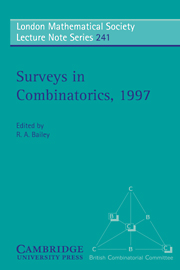Book contents
- Frontmatter
- Contents
- Preface
- M13
- The Harmonious Chromatic Number and the Achromatic Number
- Computer Construction of Block Designs
- Finite Quasiprimitive Graphs
- Tree Width and Tangles: A New Connectivity Measure and Some Applications
- Minor-monotone Graph Invariants
- Some Applications of Algebraic Curves in Finite Geometry and Combinatorics
- New Perspectives on Interval Orders and Interval Graphs
- Approximate Counting
- Author Index
- Subject Index
M13
Published online by Cambridge University Press: 29 March 2010
- Frontmatter
- Contents
- Preface
- M13
- The Harmonious Chromatic Number and the Achromatic Number
- Computer Construction of Block Designs
- Finite Quasiprimitive Graphs
- Tree Width and Tangles: A New Connectivity Measure and Some Applications
- Minor-monotone Graph Invariants
- Some Applications of Algebraic Curves in Finite Geometry and Combinatorics
- New Perspectives on Interval Orders and Interval Graphs
- Approximate Counting
- Author Index
- Subject Index
Summary
Summary The group M12 has no transitive extension, but the object of the title is the next best thing: a set of permutations which is an extension of M12. We give an elementary construction, based on a moving-counter puzzle on the projective plane of order 3, and provide easy proofs of some of its properties.
Introduction
Long ago I was intrigued by the fact that M12, É. Mathieu's celebrated quintuply transitive group on 12 letters, shares some structure with L3(3), which acts doubly transitively on the 13 points of the projective plane PG(2,3), of which it is the automorphism group.
To be more precise, the point-stabilizer in L3(3) is a group of structure 32: 2S4 that permutes the 12 remaining points imprimitively in four blocks of 3, and there is an isomorphic subgroup of M12 that permutes the 12 letters in precisely the same fashion. Again, the line-stabilizer in L3(3) is a group of this same structure that permutes the 9 points not on that line in a doubly transitive manner, while the stabilizer of a triple in M12 is an isomorphic group that permutes the 9 letters not in that triple in just the same manner.
In the heady days when new simple groups were being discovered right and left, this common structure inevitably suggested that there should be a new group that contained both M12 and L3(3), various copies of which would intersect in the subgroups mentioned above.
- Type
- Chapter
- Information
- Surveys in Combinatorics, 1997 , pp. 1 - 12Publisher: Cambridge University PressPrint publication year: 1997
- 2
- Cited by



